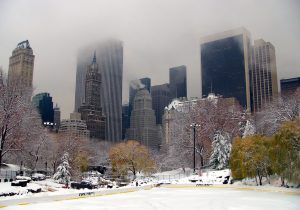The initial reception of the current Whitney Biennial was almost exclusively positive. In the days after the press preview, prominent critics agreed that the exhibition—the first since the museum inaugurated its new location in downtown Manhattan—was tasteful, balanced, and nicely installed, and moreover that it asserted a strong political stance without being obvious or hectoring. This consensus lasted only a few days before it was demolished by an angry cascade of angry objections to the inclusion of Dana Schutz’s painting Open Casket, a semi-abstract rendering of a photograph of the corpse of Emmett Till, an African-American youth who was brutally lynched in 1955 after being falsely accused of flirting with a white woman.
Protesters, one of whom staged a performative protest in front of the painting, claimed that Schutz, who is white, had thoughtlessly exploited Till’s image to her own advantage, and that in doing so she had traumatized black viewers while perpetuating white supremacy. Much attention centered around an open letter written by the artist Hannah Black and co-signed by several dozen artists of color, which called for the painting to be not only removed, but destroyed. Although the museum, the curators, and the artists have all made efforts to explain themselves, Open Casket remains on view amid some nervousness that it might be vandalized. (In a curious episode in early April, the gallery where the painting is displayed was shut down for several days; the Whitney’s press office attributed the closure to water damage following a rainstorm.)
Perhaps the most surprising thing about the controversy surrounding the show is that so many people have been surprised at all. It’s hardly shocking that there’s been a scandal; such reception is a well-established pattern in New York, a city where everyone’s a critic and where hyper-privileged consumers tend to affirm their own discrimination by competing to out-complain each other. If past editions of the Biennial are any guide, the best metric for success is to fail in the right way. Rather, what seems strange is that so few people anticipated that Schutz’s painting would turn into a flash point, when in retrospect it seems like that should have been completely obvious.
The previous edition of the Biennial in 2014 was rocked by a backlash against a project by Joe Scanlan, a white artist who presented collaborative work through a fictional African-American persona; Scanlan’s inclusion led a group called the Yams Collective to withdraw from the show in protest. Debates over similar instances of cultural appropriation have raged almost continuously since then, whether in regard to pop music (Iggy Azalea), experimental poetry (Kenny Goldsmith), or visual art (Kelley Walker).
Among the critics who lauded the show, all of whom were white, no one seems to have questioned the fact that Schutz had chosen to appropriate what one of the most powerful and racially coded photographs in U.S. history. (Images of Till’s corpse, which were reprinted in African-American magazines like Jet, are typically credited with having galvanized the civil rights movement). What’s more, she did so without having demonstrated much previous interest in the extremely complicated issue of interracial representation, and at a moment when the election of an unapologetically bigoted president has polarized race relations in the United States to a level not seen in decades.
A few weeks ago it appeared as if debate around these questions had been completely exhausted, with the low point coming when the daytime TV host Whoopi Goldberg saw fit to scold Hannah Black. However, now that people seem to be moving on (or at least pausing) several patterns are beginning to become clear. One is that Trump’s election seems to have initiated a reprise of the “culture wars” of the 1990s. Now, as then, much of the skirmishing takes place around the so-called issue of political correctness: a term widely adopted by the American right to mischaracterize demands for equal protection as mindless liberal conformity. What distinguishes the current debate is that many liberals now join conservatives in denouncing certain left tactics as “censorship.”
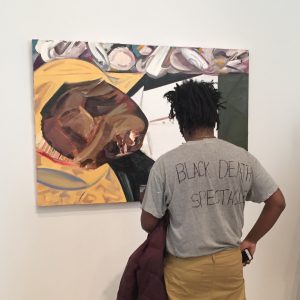
This political climate makes for strange bedfellows, as well as a contradictory position for those who have defended Schutz but would deny right-wing ideologues like Charles Murray or Milo Yiannopoulos the right to speak on a university campus. The differences between these cases notwithstanding, it should be much more clear than it is that none of them concerns free speech as such, let alone its censorship by the state. Rather, the question is whether certain speakers deserve access to a public platform whose considerable power is in fact not freely accessible to all. It is not censorship when a magazine decides to run one article and kill another; neither is it censorship for a reader to argue that an article shouldn’t have been published, or for a member of the public to claim that a painting shouldn’t be exhibited.
One persistent problem with all the furor around Open Casket has been that few arguments, whether for or against, have been able to ground their claims in a clear, closely reasoned account of how the painting’s politics are manifest aesthetically. Many critics of Schutz’s work have contrasted it with Henry Taylor’s painting of Philando Castile (The Times Thay Aint a Changing Fast Enough!), an African-American man who was fatally shot in summer 2016 by a police officer during a routine traffic stop. Yet few of them, if any, have persuasively explained how one painting’s form is racially insensitive while the other’s isn’t.
This isn’t necessarily to fault such critics; if we imagine encountering these two works blindly, not knowing anything about who painted them, it is hard to imagine that many viewers could discern some kind of indisputable, a priori difference in their ethical or political orientation. Instead, it is to suggest that judgments or suppositions about an artist’s background, race, and intentions play a crucial but largely unacknowledged role in how we evaluate art. Context matters, and so does a kind of sympathy or partiality, but few people writing about contemporary art are willing to publicly grapple with the implications of this fact.
Such discomfort surely derives from the longstanding hegemony of high modernist criticism, whether in its Greenbergian or Friedian incarnation, with its quasi-Kantian insistence on the autonomy of the work, the disinterestedness of the viewer, and the authority of the critic. It also likely has something to do with the problem that aesthetic interpretation poses for the discipline of art history, which has long suspected itself inferior to the “harder” social sciences on account of its less empirical character. Its etiology notwithstanding, such denial causes real problems in situations like the Schutz affair, insofar as critics who consider their own judgments to be impartial and rational have no way to comprehend or respond to appeals like Hannah Black’s, which are based in a keenly felt, highly politicized appeal to vulnerability and offense.
The point is not that strong feelings necessarily legitimate the measures they are invoked to justify, especially when such emotion is recruited in the defense of retrograde aesthetic or political essentialisms. Rather, it is that as long as art criticism fail to grasp the central role of affect in the politics of aesthetics, it will continue to condescend to protesters, whether by bemoaning their lack of civility or implicitly positioning them as hysterics. It will also struggle to register the extent to which the practices of artists like Schutz—along with responses to them—are necessarily informed by different kinds of political affect. (This is evidenced by the fact that no prominent critic has questioned Schutz’s clear ambivalence about her own whiteness, which is even more curious given her decision to exhibit another painting entitled Shame.)
It might be that some degree of controversy at the Whitney Biennial is inevitable, given its oft-stated ambition to somehow “take the temperature” of contemporary American art. Yet to agree to this objective is first of all to admit that such a thing is even possible and furthermore that it is desirable, when in fact neither of these points is exactly self-evident. Why shouldn’t some Biennials be more limited and thematic, rather than comprehensive? Given the extent to which debates around race have dominated the two most recent editions, it would mark a welcome shift for curators to focus more intensively on class; a subject that informs nearly every aspect of American life and yet which is in some ways strangely taboo, particularly in the art world. What about a Biennial composed of artists working outside New York, or a Biennial made up only of rural artists? Considering the profound xenophobia of the current administration, why not curate a show of work made in the U.S. by artists who aren’t American citizens?
Such questions notwithstanding, there is nevertheless something odd about the fact that such a scandal has engulfed a biennial that has historically made conspicuous efforts to address the problem of exclusion. The famously divisive 1993 edition remains the high-water mark for progressive institutional politics during the culture wars. In retrospect it looks like the moment when critical postmodernism—a term designating the sort of anti-aesthetic, content-driven, post-conceptual practices that up to that point had largely been championed by institutions like October and the Whitney Independent Study Program—began to move uptown, finding a broader mainstream audience. While subsequent Biennials haven’t all been as bold or as inclusive, by most anyone’s account the current show is remarkably diverse.
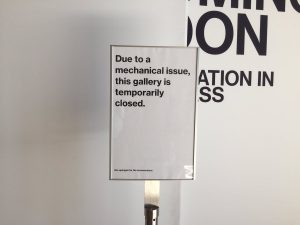
So why then has one painting led to such widespread controversy? It could be that, faced with formidably complex issues at a moment of high vulnerability, people have turned to reassuringly familiar narratives. No matter how one judges Schutz’s actions, it is far easier to scapegoat a single artist or artwork than it is to think carefully about the ways in which structural racism continues to prevail within the ostensibly enlightened, autonomous precincts of the art world. It is surely the case that the parties involved—not only Schutz and her gallerists, but the Biennial’s curators (Mia Locks and Christopher Lew) and the Whitney’s administration—badly bungled their initial efforts to respond to the crisis. Rather than meaningfully acknowledge responsibility, or grasp the crisis as an opportunity to initiate a badly needed conversation, they have acted as if it were a threat to be countered or a PR disaster to be contained. Public statements have been embarrassingly slow in coming, and couched in an evasive, generalizing, and faintly patronizing rhetoric of good intentions.
Yet one wonders whether part of the problem is that Open Casket sticks out sorely in an exhibition whose most pronounced trait seems to be its aversion to unpredictability. As some have noted, the show is balanced almost to a fault: no one medium or style predominates; activism and formalism coexist; while the roster skews young, it includes underheralded elders like Larry Bell and Jo Baer. Something similar is true of the works on view, which are rarely formulaic but just as rarely challenge, puzzle, or beguile viewers. Very few pieces go out on a limb, and the ones that take the greatest risks—or at least the most obvious ones—are generally the worst in the show. (While Schutz’s fiasco wins first prize, a special dishonorable mention has to be given to Jordan Wolfson’s Real Violence, a senseless and utterly gratuitous spectacularization of ultraviolent bro id, which is inexplicably installed in such a way that it obscures a very thoughtful and well-executed piece by Park McArthur, an excellent artist who deserves much better treatment.)
Thanks to Wolfson and his many Bad Boy Art Star forefathers, the criteria for “transgressive” art have been pushed well past the point where they might be worth transgressing. If this means that radical artists are now often pushed to adopt less obviously provocative strategies—itself not necessarily a bad thing—it also suggests that contemporary art spaces like the Whitney can now inadvertently act as sites of something like what Herbert Marcuse called repressive tolerance. The more supposedly dangerous or scandalous a work is, the more it makes the museum look “edgy”, rather than staid. Within such an environment, the biggest risk a curator can take is to promote art that doesn’t conform to our prefabricated ideas of what art looks like or how it operates. Few if any works in the show would have looked out of place in a New York gallery; the only question is what type of collector they would best appeal to.
The obvious irony is that an overly cautious exhibition has now been defined by one of the few works in the show that took a genuine risk, albeit one that was disastrously miscalculated. It is understandable that relatively young curators like Locks and Lew would shy away from uncertainty; unlike the startup industry, which fetishizes failure, any sort of perceived misstep tends to be strongly discouraged in their field. However, such aversion can have unfortunate consequences, particularly when it comes to more politically ambitious art.
When curators opt to play it safe, politics easily becomes a familiar source of content, not to mention a means by which institutions can engage in “virtue-signalling.” It is revealing in this respect that the same mainstream liberal critics who failed to grasp the implications of Schutz’s appropriation—most prominently Roberta Smith, Peter Schejldahl, and Jerry Saltz—were unanimous in their approval for the way that the Biennial seemed to reconcile art and politics. Unlike 1993, they seem to feel, it now isn’t necessary to choose sides; one can love painting and beauty and dismiss art that is overly “difficult” or “political” or “theoretical” or “issue-oriented,” all the while maintaining a clear conscience.
Another unhappy irony of the Schutz affair is that other artists in the show have produced much more thoughtful responses to the questions she so badly botched, but have failed to get the attention they deserve. Deplorably, although also of course predictably, it goes without saying that most of them aren’t white; nor are they represented by blue-chip galleries. While it is worth seeing Open Casket in person—partly to see for oneself how utterly bizarre and mistaken the painting is, partly because in all likelihood it will never be exhibited again—visitors to the Biennial would do best to get it out of the way first, then spend the majority of their time with those works that most reward concentrated engagement.
In a show where many pieces strive to make a big impact, whether to compete for eyeballs or to fill the Whitney’s massive, costly new galleries, some of the most powerfully generative art is the most modest-looking. One work that stands out in this respect is Zarouhie Abdalian’s Chanson du ricochet, a sound installation located in an outdoor stairwell. With little to see apart from a set of unremarkable loudspeakers, viewers’ attention is drawn to recordings of anonymous voices with unplaceable accents reading a kind of concrete poem assembled by the artist from terms used in the slaughterhouses that used to populate Manhattan’s Meatpacking District. Some of these are brutal (“wrecking bar,” “choke-strap”), others ominous (“spirit level”), still others archaic or obscure (“two-square,” “quick prod”). Just as the threshold between past and present becomes permeable, so does the boundary separating the work from the city; ingeniously, the piece makes sound bleed and noise pollution into essential parts of its “medium”.
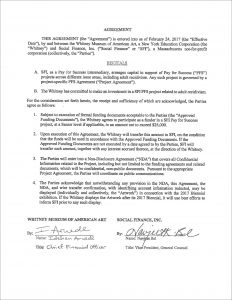
Another crucial but easily overlooked piece is Cameron Rowland’s Public Money, for which the artist persuaded the Whitney to invest in a Social Impact Bond: an arrangement whereby cash-strapped local governments raise funds by privatizing basic social services (in this case, an anti-recidivism program in Southern California). Although programs are typically marketed as win-win situations in which socially responsible investors “do well by doing good,” the piece clearly shows how such framing obscures their function as agents of neoliberalization. However, by implicating the museum and his own practice in this process, Rowland raises important, unsettling questions about how culture is determined by this larger political economy. At the same time he displays pitch-perfect irony, satirizing the self-seriousness of much Institutional Critique while exploring the absurdity of making art from non-disclosure agreements.
Not all the best work in the show is subtle. Claim (Whitney Version), the contribution of the artist now apparently known as “Pope.L aka William Pope.L,” is an enormous gallery-within-the-gallery festooned with some 2,755 slices of bologna, each of which bears a degraded photocopy that supposedly depicts a Jewish resident of New York. Apart from brilliantly mocking the pretensions of the art establishment—a major art news website actually ran an article about how bad it smelled—the piece somehow managed to darkly satirize both entrenched American racisms and the liberal sensibility that wishes to somehow magically transcend them. A gnomic text by the artist informs us that over time the bologna will “weep”; this crying baloney is not only a hilariously disgusting description of the work’s abject materiality, but also a damning indictment: race and racism are pure bullshit, but so are pious denunciations of these problems that don’t reckon with their intractability.
While Pope.L’s installation is the only work in the show to so blatantly critique its own outsized scale, several other pieces manage to show that large work doesn’t necessarily have to be monumental or un-self-conscious. The indigenous Southwestern collective Postcommodity, who have produced memorable site-specific installations at and around the U.S.-Mexico border, is represented by A Very Long Line, a multi-channel video projection that plunges viewers into a torrent of images of the American border wall. It is disorienting on the level of one’s most basic bodily perception—some viewers become nauseated—yet while the cumulative effect is punishing the piece isn’t just about white guilt. Even though Trump and Trumpism are almost physically palpable, the artists also manage to evoke the way that migrant histories are written and overwritten, while suggesting that border politics are predicated upon a kind of collective paranoid dissociation.
The New York-based initiative Occupy Museums addresses a different kind of quasi-colonial politics by devoting an installment of their ongoing Debtfair project to American artists from Puerto Rico, who are legally U.S. citizens yet lack statehood, Congressional representation, and many basic protections and benefits. In an imposing floor-to-ceiling display where a tranche of artists is cleverly curated or “bundled” according to their creditors, the group not only reveals the extent to which contemporary art and art education have become a revenue stream for companies like BlackRock (whose CEO Larry Fink, a MoMA trustee, serves as an economic adviser to Trump); it also shows how the condition of indebtedness permeates the lives of younger artists, along with whatever work they make.
One place where the Biennial unambiguously succeeds is in showing work by artists who have yet to receive sustained high-profile exposure. Kaari Upson is one; her life-sized urethane casts of abandoned furniture speak obliquely to the ongoing American housing crisis because the lack of affordable homes affects all ages, yet attain a kind of strange autonomy by virtue of their compelling, lurid color gradients. Harold Mendez also works with detritus, combining unrecognizable scraps of iron with a jarring array of other objects—carnations, crushed insects, staples—to form poised, starkly poetic assemblages.
Two other artists who display outstanding potential are Sky Hopinka and Ajay Kurian. Hopinka’s video Visions of an Island is a quietly devastating depiction of a remote Alaskan island with the world’s largest Aleut population. Combining long takes of the landscape, wry vignettes of children playing, and evocative superimpositions of sea and sky, the video recalls James Benning or Andrei Tarkovsky without ever seeming derivatively arty; it takes its subject with complete seriousness and yet never indulges in self-mythologization or humanitarian pathos. In contrast, Kurian’s Childermass, installed in a stairwell, imposes a kind of astonishment. More so than any other work in the show, it evades adequate description and demands to be seen for itself. Suffice it to say that Kurian has something like Isa Genzken’s sardonic genius for juxtaposition, but directs this impulse toward much less familiar and much more topical ends. Over and against the loathsome trivialities of Wolfson and his ilk, Kurian shows that in rare cases art can still make worthwhile use of its power to alienate.
There are a few moments where the exhibition seems to want to make a larger argument about the predicament in which American art now finds itself, even as it wisely refrains from making any epochal pronouncements. In John Divola’s series Abandoned Paintings, discarded paintings by art students are displayed in abandoned buildings, then photographed. Despite this rather obvious, redemptive conceit, the photographs themselves exude a grim loyalty to the rigors of art, a sentiment powered by the simultaneous recognition and denial of art’s apparent futility.
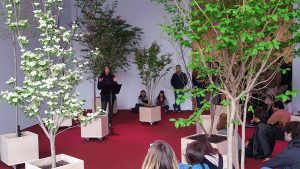
Asad Raza’s Root sequence. Mother tongue initially seems to be either an instance or a parody of a certain kind of biennial art: the piece consists of several dozen trees of different species, which are looked after by a rotating cast of attendants who inform viewers about their special properties (intriguingly, these include Manthia Diawara and Gayatri Chakravorty Spivak). It is easy to overlook the small objects embedded mysteriously by the trees’ trunks, or to miss the oblique allusion to the winter garden: a relic of the European aristocracy whose history has been critically explored by figures as various as Roland Barthes, Marcel Broodthaers, and Dan Graham.
Like the winter garden, art can not be extricated from a history of domination, which both subtends and continues into the present. Like the winter garden, art is at once a refuge and a highly artificial environment, an elaborate display of hothouse flowers that couldn’t exist outside. In a moment of generalized paranoia, when figures across the political spectrum warn that some sort of winter is on its way—this even as the prospect of permanent summer continues to be denied by so-called “climate change skeptics”—works like Raza’s suggest a different response, one that is premised on unexpected conversations, cognizant of collective vulnerability, and rooted in but not disabled by an awareness of art’s constitutive contradictions.


